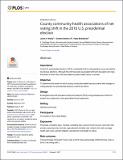| dc.contributor.author | Wasfy, Jason H. | |
| dc.contributor.author | Bhambhani, Vijeta | |
| dc.contributor.author | Stewart III, Charles H | |
| dc.date.accessioned | 2018-04-24T18:08:04Z | |
| dc.date.available | 2018-04-24T18:08:04Z | |
| dc.date.issued | 2017-10 | |
| dc.date.submitted | 2017-01 | |
| dc.identifier.issn | 1932-6203 | |
| dc.identifier.uri | http://hdl.handle.net/1721.1/114940 | |
| dc.description.abstract | Importance
In the U.S. presidential election of 2016, substantial shift in voting patterns occurred relative to previous elections. Although this shift has been associated with both education and race, the extent to which this shift was related to public health status is unclear.
Objective
To determine the extent to which county community health was associated with changes in voting between the presidential elections of 2016 and 2012.
Design
Ecological study with principal component analysis (PCA) using principal axis method to extract the components, then generalized linear regression.
Setting
General community.
Participants
All counties in the United States.
Exposures
Physically unhealthy days, mentally unhealthy days, percent food insecure, teen birth rate, primary care physician visit rate, age-adjusted mortality rate, violent crime rate, average health care costs, percent diabetic, and percent overweight or obese.
Main outcome
The percentage of Donald Trump votes in 2016 minus percentage of Mitt Romney votes in 2012 (“net voting shift”).
Results
Complete public health data was available for 3,009 counties which were included in the analysis. The mean net voting shift was 5.4% (+/- 5.8%). Of these 3,009 counties, 2,641 (87.8%) had positive net voting shift (shifted towards Trump) and 368 counties (12.2%) had negative net voting shift (shifted away from Trump). The first principal component (“unhealthy score”) accounted for 68% of the total variance in the data. The unhealthy score included all health variables except primary care physician rate, violent crime rate, and health care costs. The mean unhealthy score for counties was 0.39 (SD 0.16). Higher normalized unhealthy score was associated with positive net voting shift (22.1% shift per unit unhealthy, p < 0.0001). This association was stronger in states that switched Electoral College votes from 2012 to 2016 than in other states (5.9% per unit unhealthy, p <0.0001).
Conclusions and relevance
Substantial association exists between a shift toward voting for Donald Trump in 2016 relative to Mitt Romney in 2012 and measures of poor public health. Although these results do not demonstrate causality, these results suggest a possible role for health status in political choices. | en_US |
| dc.publisher | Public Library of Science (PLoS) | en_US |
| dc.relation.isversionof | http://dx.doi.org/10.1371/JOURNAL.PONE.0185051 | en_US |
| dc.rights | Creative Commons Attribution 4.0 International License | en_US |
| dc.rights.uri | https://creativecommons.org/licenses/by/4.0/ | en_US |
| dc.source | PLoS | en_US |
| dc.title | County community health associations of net voting shift in the 2016 U.S. presidential election | en_US |
| dc.type | Article | en_US |
| dc.identifier.citation | Wasfy, Jason H. et al. “County Community Health Associations of Net Voting Shift in the 2016 U.S. Presidential Election.” Edited by Sarah Gollust. PLOS ONE 12, 10 (October 2017): e0185051 © 2017 Wasfy et al | en_US |
| dc.contributor.department | Massachusetts Institute of Technology. Department of Political Science | en_US |
| dc.contributor.mitauthor | Stewart III, Charles H | |
| dc.relation.journal | PLOS ONE | en_US |
| dc.eprint.version | Final published version | en_US |
| dc.type.uri | http://purl.org/eprint/type/JournalArticle | en_US |
| eprint.status | http://purl.org/eprint/status/PeerReviewed | en_US |
| dc.date.updated | 2018-04-20T18:04:42Z | |
| dspace.orderedauthors | Wasfy, Jason H.; Stewart, Charles; Bhambhani, Vijeta | en_US |
| dspace.embargo.terms | N | en_US |
| dc.identifier.orcid | https://orcid.org/0000-0003-1428-7308 | |
| mit.license | PUBLISHER_CC | en_US |
